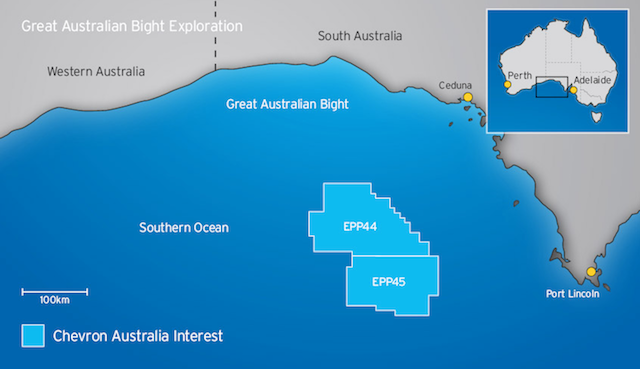Last week, Chevron Corp.’s Australian venture announced it had abandoned plans for drilling four deepwater exploration wells in the Great Australian Bight, a promising oil frontier rivaling the prolific southeastern Bass Strait.
The Bass Strait has produced for nearly 40 years, yielding more than four billion barrels of oil and eight trillion cubic feet of natural gas. It marked a key discovery in the Australian oil and gas industry’s development in the late 1970s. But that was then, and this is now.
The Australian Bight is not the Bass Strait, but early seismic analysis suggests it is a promising region for oil and gas production. The challenge for oil companies is that the region, which lies offshore South Australia and Western Australia, is in a marine reserve, home to whales and sea lions. It is a rich fishing ground and a place where tourists go to observe great white sharks from steel cages suspended under water. However, the region is also known for extreme weather, and was a target of environmentalists seeking to prevent drilling to reduce the risk to the area’s wildlife and coastline.
In late 2013, Chevron bought two licenses covering 12,000 square miles. It planned four exploration wells to test the conclusions from its seismic work. This year, the company submitted plans for the wells, each estimated to cost AUS$100 million ($78 million). Given an historical exploration success rate of 14%, this was a significant gamble by Chevron.
So what killed the project? Obviously there was extensive pushback from environmentalists over the drilling effort. The Australian government’s oil and gas regulator recently requested additional information from BP plc, who was also considering drilling in the Australian Bight, about how it would handle environmental risks. While neither oil giant acknowledged its decision to abandon the region was the result of these environmental or regulatory issues, both companies said the exploration effort was no longer commercially viable given other projects in their respective drilling portfolios. With a one-in-seven prospect of drilling success, the $78 million wells can’t match up with onshore shale prospects, which have no exploratory risk.
Furthermore, the quick payback from shale wells is a competitive hurdle for expensive, risky deepwater wells. Adding to the quick cash flow payback advantage of shale is the long development timetable for a deepwater discovery in a remote area of the world. Many oil companies are wrestling with what the oil business will look like in seven to 10 years or longer, when assessing deepwater drilling projects. That concern tips the scales in favor of U.S. deepwater, assuming breakeven well costs can be lowered to provide at least a 10% rate of return on flat oil price projections. Oil produced in the Gulf of Mexico is destined for a market that despite rising shale output still imports a substantial volume of crude oil every day. In other words, a domestic deepwater discovery in the Gulf is assured of a market for its oil, regardless of what happens to OPEC. The same cannot be said for Australian deepwater wells.
In a world of limited exploration capital, oil companies have many factors to consider when choosing which projects to fund. The recovery of offshore drilling, especially in deepwater, will continue. Initially, however, it will be focused in regions where future market demand for a well’s output is predicted to be high. That is a major mitigating factor in exploration risk assessment.
Until long-term oil market output clears, increased deepwater drilling activity will likely be limited to more mature offshore basins with access to markets that consistently need more oil. It is one more reason why the offshore recovery will be slow.




